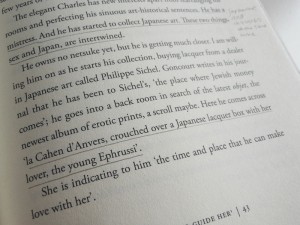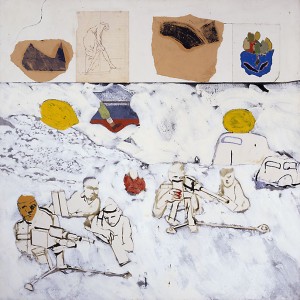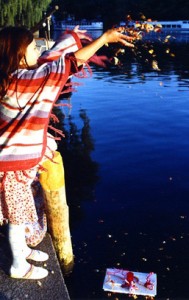An unexpected success in England and still climbing bestseller rungs all over the world, The Hare with the Amber Eyes by Edmund de Waal is an exhibition in book form. The author, a potter, tells the history of his Jewish banking family, the Ephrussis, via the artifacts it collected, cared for, and bequeathed. 
The objects gain meaning via detailed descriptions. Who acquired them, at which time, for what purpose? What do they say about their buyer’s character, heritage, and destiny? Among the artifacts is the title-giving “Hare with Amber Eyes,” one of 264 Japanese netsuke wood and ivory carvings, which changes hands many times. → continue reading

R.B. Kitaj, Kennst Du das Land?, 1962 © R.B. Kitaj Estate
A few years ago during a summer spent in Catalonia, I strolled through the port city of Sant Feliu de Guíxols. It is a special place: it was spared the transgressions of the Spanish coast’s building mania due to its fishing industry. It is not merely decorative but in fact successful in a particular industrial branch: producing cork. And here – nominally part of Spain but somehow a place all of its own – R.B. Kitaj and his wife spent the winter of 1953/54. Twenty years later, he bought a house in this town. What did it mean to him, this stubborn region that again and again rebelled against Spanish supremacy? → continue reading
 A few years ago, a guest lecturer from New York visited the Berlin synagogue at Fraenkelufer and showed our congregation a new way of practicing an old Rosh ha-Shanah custom, that of tashlikh.
A few years ago, a guest lecturer from New York visited the Berlin synagogue at Fraenkelufer and showed our congregation a new way of practicing an old Rosh ha-Shanah custom, that of tashlikh.
Usually Jews gather for the New Year holiday at the bank of a river and scatter breadcrumbs in the water as a symbolic way of shedding their misdeeds of the last year. The American professor did not strew breadcrumbs in the canal across from the synagogue however; rather, she placed a little homemade paper boat into the water, in which she’d tucked a letter to God. In the letter, she begged for forgiveness for her offences and affirmed her resolutions. The letter also contained thanks for the good experiences of the last year and her wishes for the coming one. → continue reading


